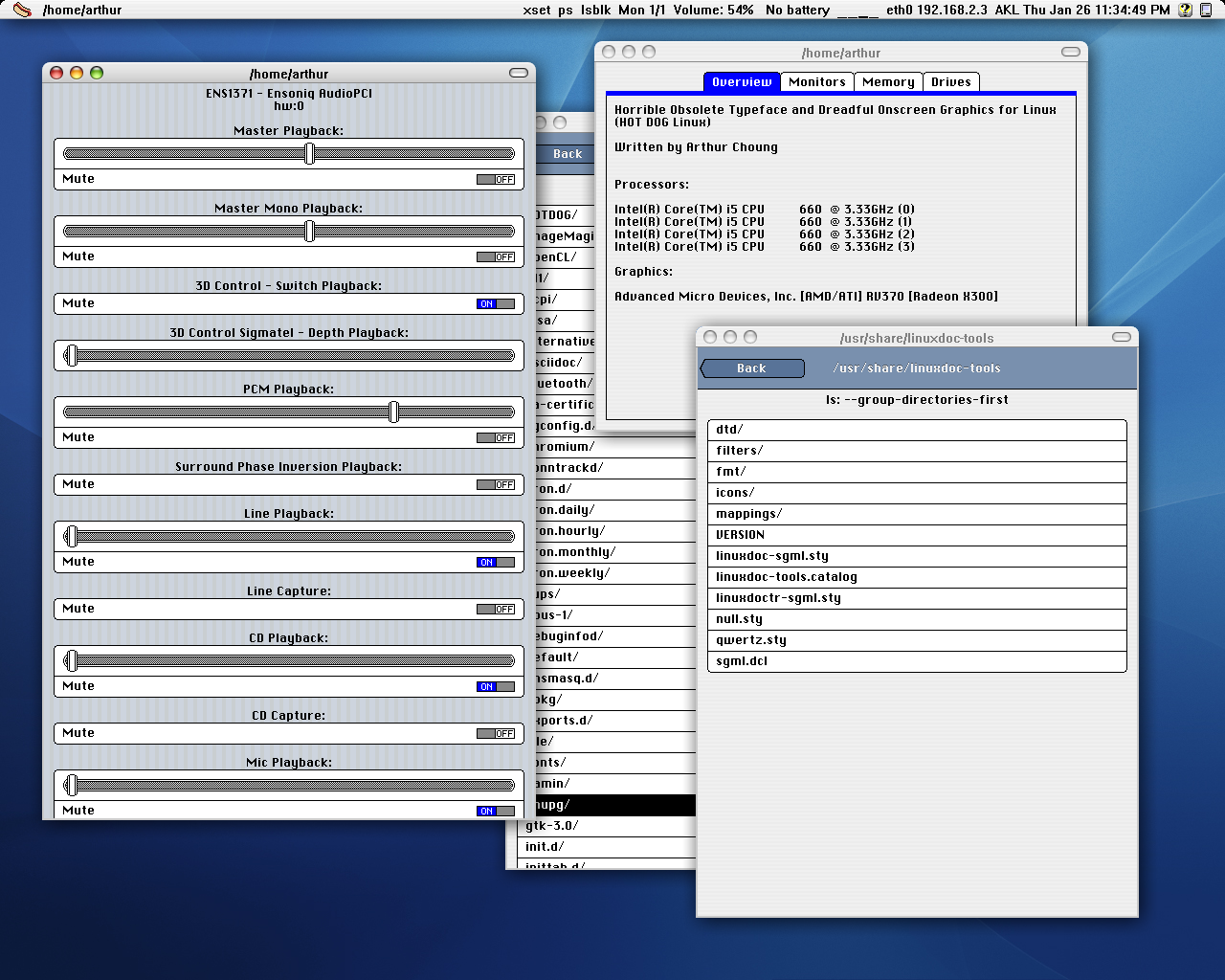Unline modern macOS clones this actually look in line with Apple did...

Thabks for the suggestion - I played around with hot dog Linux today - works really well
MLVWM is a classic mac window manager for X11
https://github.com/morgant/mlvwm
Also you will need
https://github.com/morgant/mlvwmrc
Also bonus: Mac OS 8 startup for Plymouth
Ooh, I wonder how the menu bar works across apps since most are designed to have menus in-window. I remember older versions of KDE used a global menu bar and there were some hacks to move some GTK apps' menus into there as well, but it wasn't totally consistent.
Might have to give this a try.
BTW modern KDE still has this as a module and it works pretty well with both Qt and GTK programs (though with GTK it sometimes shows it in both locations).
I'd look at kde-look.org if there's something.
Q for all those with suggestions: do any of these attempt to replicate the Spatial Finder? No other system I’ve seen (contemporary to OS 9 or since then) seems to have got this element correct (or even attempted to do so).
It’s such a key part of the OS 9 (and earlier) experience. Double click a folder and it opens where you expect it to, in the shape you left it, with the icons laid out as you left them. It’s a method of working that gives you great familiarity and confidence.
If anyone’s worked in a kitchen or workshop for a long time and developed a deep memory for the layout and the location of every tool, material, and control, then they’ll know what I’m talking about. You can move around and work incredibly efficiently, relying greatly on muscle memory.
Since the demise of OS 9, the only way to retain this level of operation has been to rely heavily on the keyboard. Since almost everything on the screen is transient and unreliably positioned (non-spatial), only the keyboard is persistent enough to allow us to work at the speed of thought and rely on muscle memory. It’s been so long now that I think people forget (or never knew) that the contents of the screen could also be persistent and spatial this way.
The Caja file manager from MATE has a spatial mode. I think ROX-filer does as well.
That sounds really nice. What if you changed systems? Would the spatialness also change over to the other system? Was there like a hidden file in the folder or somewhere else that defined where everything was?
All the spatial persistence stuff was handled by the desktop database which was an invisible file that got stored on the disk. Hard drives and floppies each had their own so that if you shared a floppy with a friend the spatial properties of the floppy would travel with it. This also worked if you moved a hard drive from one system to another for the same reason.
It also worked over AppleShare network file sharing. Where it didn’t work was if you had 2 different computers since there was no way to sync information between them. You essentially treated each computer as its own thing which is really more in keeping with the spirit of spatial design. After all, it would be really weird if 2 different drawers in different rooms in your house somehow always had identical contents which stayed in sync.
The tricky point to your needs is getting the app's menu bar in the top bar. The rest are easy to do with almost all desktop environments. But getting the menu bar on the top bar, I think currently only KDE supports it (with a plugin), and MATE (with another plugin).
However, if you want the general feel of how MacOS 9/X feels, then Gnome with extensions would be your best bet. The rest feel more like simpler Windows, but in a mac skin. Gnome+extensions feel more accurately like a Mac, in terms of overall usability (even if the looks aren't 100% there). So it depends what you're after more: the feeling of using a mac, or the exact looks of it.
Closest I got was with xfce. You can grab all the themes you need from xfce-look.
Linux
From Wikipedia, the free encyclopedia
Linux is a family of open source Unix-like operating systems based on the Linux kernel, an operating system kernel first released on September 17, 1991 by Linus Torvalds. Linux is typically packaged in a Linux distribution (or distro for short).
Distributions include the Linux kernel and supporting system software and libraries, many of which are provided by the GNU Project. Many Linux distributions use the word "Linux" in their name, but the Free Software Foundation uses the name GNU/Linux to emphasize the importance of GNU software, causing some controversy.
Rules
- Posts must be relevant to operating systems running the Linux kernel. GNU/Linux or otherwise.
- No misinformation
- No NSFW content
- No hate speech, bigotry, etc
Related Communities
Community icon by Alpár-Etele Méder, licensed under CC BY 3.0